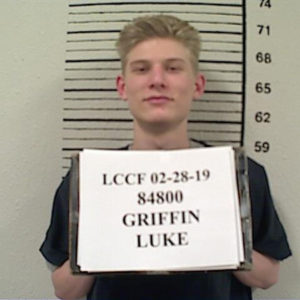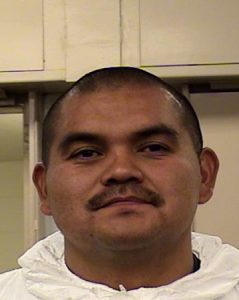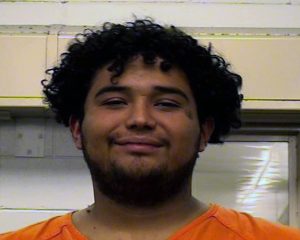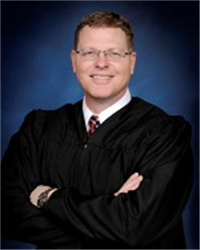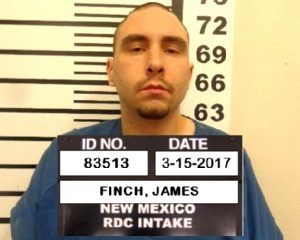- Suspect: Taylor James Enriquez
- Victim: Alberto Nunez
- Non-fatal victim: Manuel Lopez Polanco
- Charges: First-degree murder, false imprisonment and aggravated battery causing great bodily harm
- Status: Guilty plea to second-degree murder, false imprisonment and aggravated battery causing great bodily harm
- Sentence: 19 1/2 years
- Date of incident: Feb. 26, 2017
- Agency: Las Cruces Police Department
- Location: 600 block of South Manzanita Street, Las Cruces
- Magistrate case number: M-14-Fr-2017-170
- District case number: D-307-CR-2017-272
- Pathologist: Lauren Edelman, Kurt Nolte
Summary
On Feb. 26, 2017, Taylor Enriquez allegedly walked into the back yard of his friends house and, after a short fight, stabbed Alberto Nunez repeatedly in the neck with a broken bottle, killing him.
Enriquez pleaded guilty to charges of second-degree murder, false imprisonment and aggravated battery causing great bodily harm on April 10, 2018, accepted by District Court Judge Douglas Driggers, with a maximum sentence of 19 1/2 years.
On July 9, 2018, Driggers sentenced Enriquez to the maximum allowed, 19 1/2 years.
The incident
On Feb. 26, 2017, Las Cruces Police Department officers were sent to a house on South Manzanita Street following the report of a fight, Detective Felix Guerra wrote in a statement of probable cause for Taylor Enriquez’s arrest.
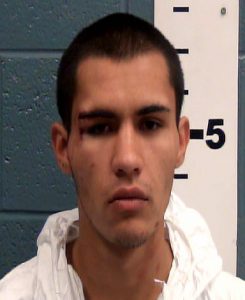
At the scene, they find Jennifer Barraza, Manuel Lopez Polanco, Edwin Lopez and Enriquez.
Lopez Polanco, Edwin Lopez’s father, had injuries to his face and was transported to the hospital and Enriquez also had facial injuries. He was not wearing a shirt but his pants and shoes were allegedly covered in blood, more than would be consistent with his injuries, Guerra wrote.
When officers checked the back of the house, they found Alberto Nunez with alleged stab wounds to the neck.
“The officers could see signs of a struggle in the back yard and a broken wooden handle,” Guerra wrote. “The jagged end of the broken wooden handle was covered in a red substance believed to be blood.”
Interview with Jennifer Barraza
Barraza told Guerra that she lives at the house with her boyfriend, Edwin Lopez, and Lopez’s father, Manuel Lopez Polanco, and her 1-year-old daughter.
The day of the alleged killing, Lopez and herself were invited to a party at Peter Piper Pizza but before going, they met with Nunez, Edwin Lopez’s cousin. Nunez wanted to come back with them to see his cousin, Lopez Polanco, Guerra wrote.
They left him at the house so they could to go the birthday party. When they came back, she found Lopez Polanco had an injury to his eye and was bloody and another man she only knew as “T. J.”
“She notices that T.J. has a black eye and he has a blank look on his face,” Guerra wrote. “She asked what happened and T.J. said ‘he killed him.'”
She went to tell Lopez that T.J. hit his father and Lopez begin to hit Enriquez.
“When she looks on the side of the house she sees Alberto on the ground,” Guerra wrote. “She asks T.J. what happened. T.J. tells her Edwin’s dad killed him. Edwin goes outside and sees Alberto on the ground. Edwin touches Alberto and says Alberto is dead. She goes to the front of the house and calls the police.”
Interview with Edwin Lopez
Lopez repeated much of what Barraza told Guerra, about picking Nunez up and going to the party.
“His girlfriend goes in the house first,” Guerra wrote. “He can hear her yelling “Babe, Babe, Demon is hitting your dad!” he enters the house and he sees that his dad Manuel Lopez Polanco has injuries to his face.”
When he asked what happened, Lopez Polanco allegedly said that the guy “did it.”
“He asks Taylor what happened,” Guerra wrote. “Taylor tells him ‘the Guero did it.’ He looks toward the side of the house and he sees his cousin Alberto on the ground. He sees that he is bloody and not moving. He touches Alberto’s ch in and shakes Alberto’s face . He tries to get Alberto to open his eyes. Alberto does not respond and he can feel that Alberto is cold to the touch.”
Lopez told Guerra he began to panic and called his brother Hector and his cousin, Danny, who is Nunez’s brother. He then grabbed Enriquez and held him until police arrived.
Interview with Manuel Lopez Polanco
Lopez Polanco left the house around 9 in the morning and had a few beers and returned home around sunset. He walked to the back yard and once inside, he saw his nephew on the ground and a “young man” allegedly standing over him, Guerra wrote.
“The young man rushes him and grabs him by the wrists,” Guerra wrote. “The young man knocks him down to the ground and begins to punch his face. The young man puts his knee on his chest pinning him down. The young man continues to punch him on the face as he tells the man to stop. He tells the young man to stop hitting him and the man stops and lets him up. He walks to the side of the house and he is alone with the man for at least 30 minutes.”
Interview with Taylor Enriquez
The day of the incident, Enriquez allegedly said that he walked to the back yard of the house on South Manzanita Street.
“He sees a man in the back yard and they are singing and talking together,” Guerra wrote. “The man started talking about the man’s mom and grandma.”
Guerra does not specify who “they” are.
“The man started tripping so he postured up to him,” Guerra wrote. “He threw a punch and hit the man on the face. The man threw a punch at him. He ducked and spun around the man and flipped him over. The man fell on the ground. The man picked up a shovel and tried to hit him with the shovel. He ducked and avoided the strike.”
He allegedly took the shovel away from Nunez, then used it to hit him in the side of the neck. He then allegedly found a bottle on the ground, picked it up and hit him on the head with it, Guerra wrote.
“The bottle breaks and he then stabs the man on the neck with the bottle,” Guerra wrote. “The man falls to the ground and the man is still breathing.”
Lopez Polanco then allegedly walked up, saw the dead man and asked what Enriquez had done.
“Manuel throws a punch at him and he moves out of the way,” Guerra wrote. “He grabs Manuel and throws Manuel to the ground. He grabs Manuel’s wrists and he puts his knee on Manuel’s chest. He holds Manuel down and he punches Manuel on the face. Manuel tells him to stop and he holds Manuel down for around 20 minutes.”
When Barraza and Lopez arrive, he allegedly let Lopez Polanco get up and then Lopez tried to fight with him.
“Edwin kicks him on the chest and he falls down and hits his face on the sidewalk,” Guerra wrote. “A short time later the police arrive.”
Injuries all around
Guerra wrote that Lopez Polanco required stitches to his face and he also had several bruises.
Officers also located a neighbor with surveillance cameras that faced the back yard.
“The video footage is dark but has audio recording of the incident,” Guerra wrote. “The audio had the sounds of someone telling another person to stop several times as the sounds of a person being struck is hard.”
The sounds of striking stopped and a few minutes later and someone arrived at the house. Then, the screaming started.
“Someone is heard asking what did you do, and who killed him, you killed my cousin, you’re not going anywhere, why would you do that T.J., you killed my cousin, T.J,” Guerra wrote.
Enriquez, while being escorted to the hospital, yelled at Barrazas that what he did was in self defense.
After leaving the hospital, he was taken back for an apparent drug overdose. Officers found he was foaming at the mouth, shaking and mumbling, Guerra wrote.
Enriquez was arraigned two days later, Feb., 28, 2017, and placed on a no-bond hold.
Below is the statement of probable cause written by Guerra.
PC - Taylor Enriquez_RedactedAutopsy report
Forensic Pathology Fellow Lauren Edelman and Pathologist Kurt Nolte wrote in the autopsy report that Nunez-Lopez died from a slashing wound on his neck and strangulation. His blood-alcohol level was 0.30.
The indictment
On March 9, 2017, a grand jury indicted Taylor Enriquez on charges of:
- First-degree murder
- False imprisonment
- Aggravated battery causing great bodily harm
Plea and sentencing
Enriquez pleaded guilty to charges of second-degree murder, false imprisonment and aggravated battery causing great bodily harm on April 10, 2018, accepted by District Court Judge Douglas Driggers.

According to the plea agreement, Enriquez was going to face a maximum sentence of 19 1/2 years in prison and that the sentences for each crime would run consecutively, or one after another. His defense attorney, James Baiamonte, agreed that he would argue for a minimum sentence of 15 years followed by five years of supervised probation while prosecutors would argue for 19 1/2 years.
On July 9, 2018, Driggers sentenced Enriquez to the maximum allowed, 19 1/2 years. Although second-degree murder carries a maximum sentence of 15 years, Enriquez was also sentenced to the maximum sentences on the charges of false imprisonment and aggravated battery.
Both aggravated battery and second-degree murder are serious violent offenses, meaning Enriquez will have to serve 85 percent of those sentences (15 and three years, respectively) before he will be eligible for parole. The charge of false imprisonment, of a year and a half, was not considered a serious violent offense and he must only serve half of that sentence.
Driggers also gave Enriquez credit for time served while awaiting trial, one year and 130 days. He was also ordered to have no contact with the victim’s family.
